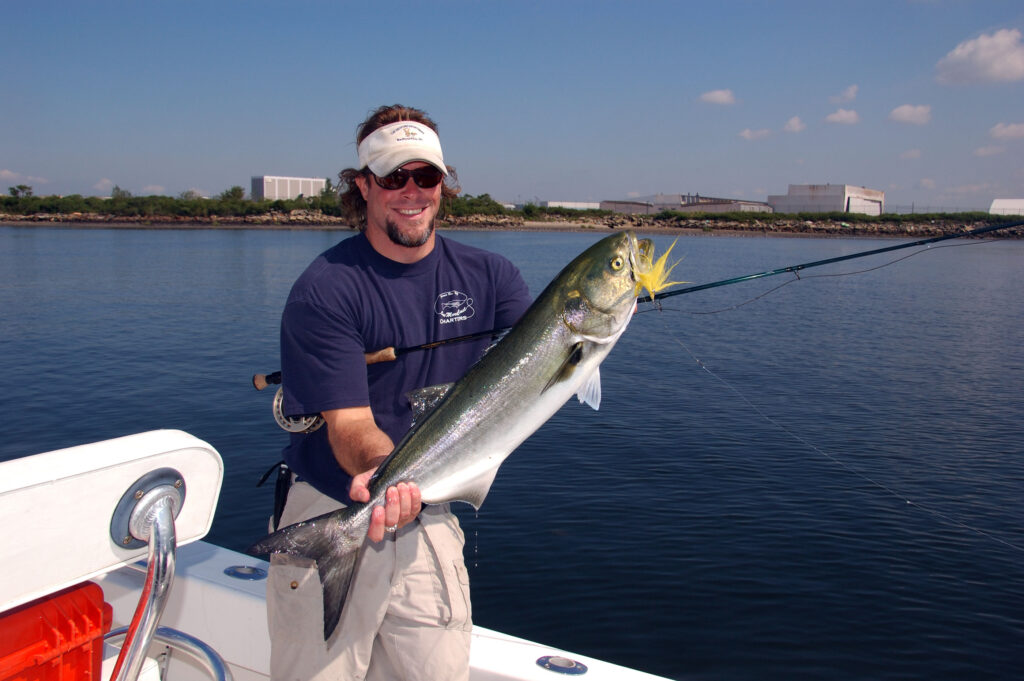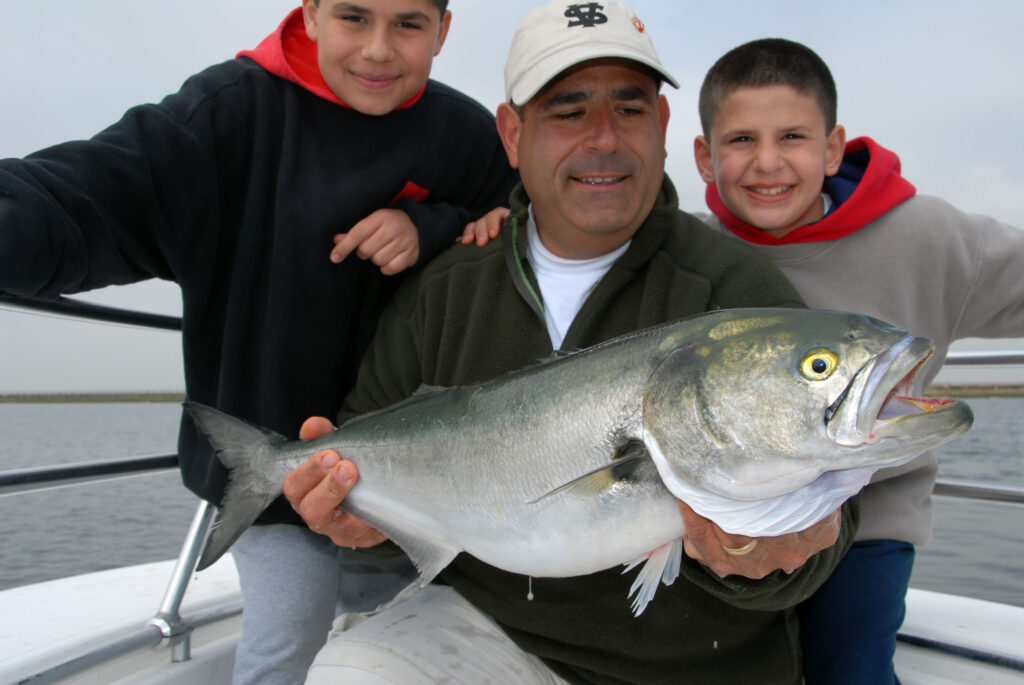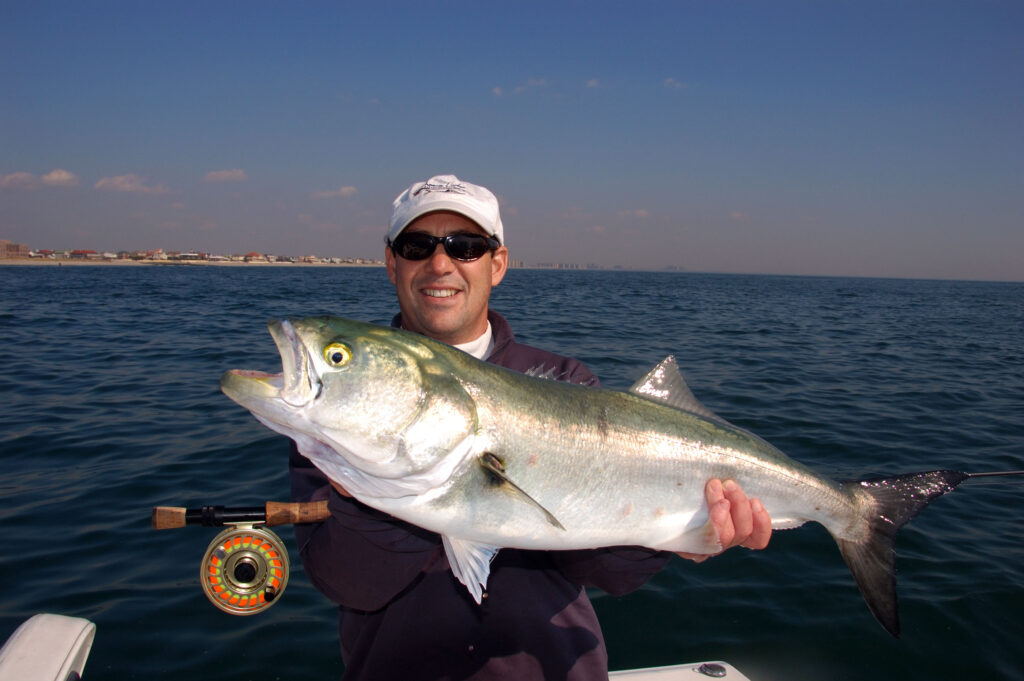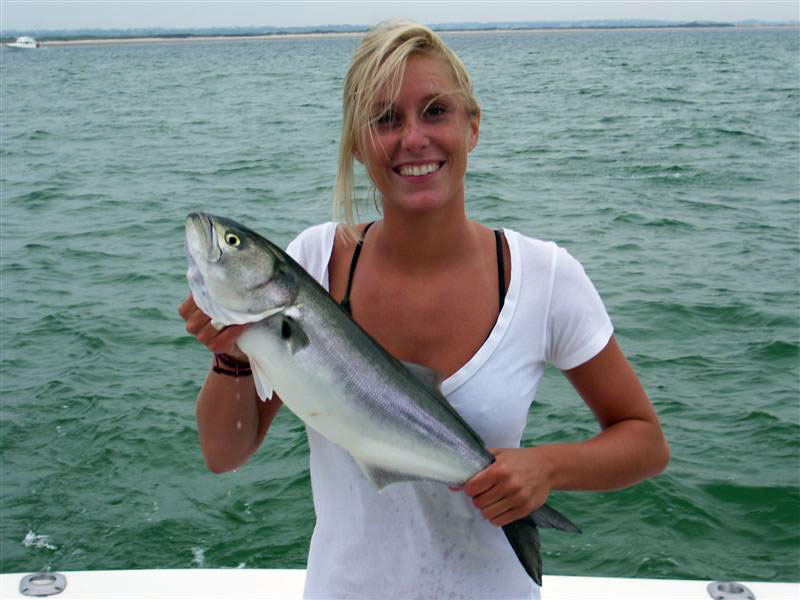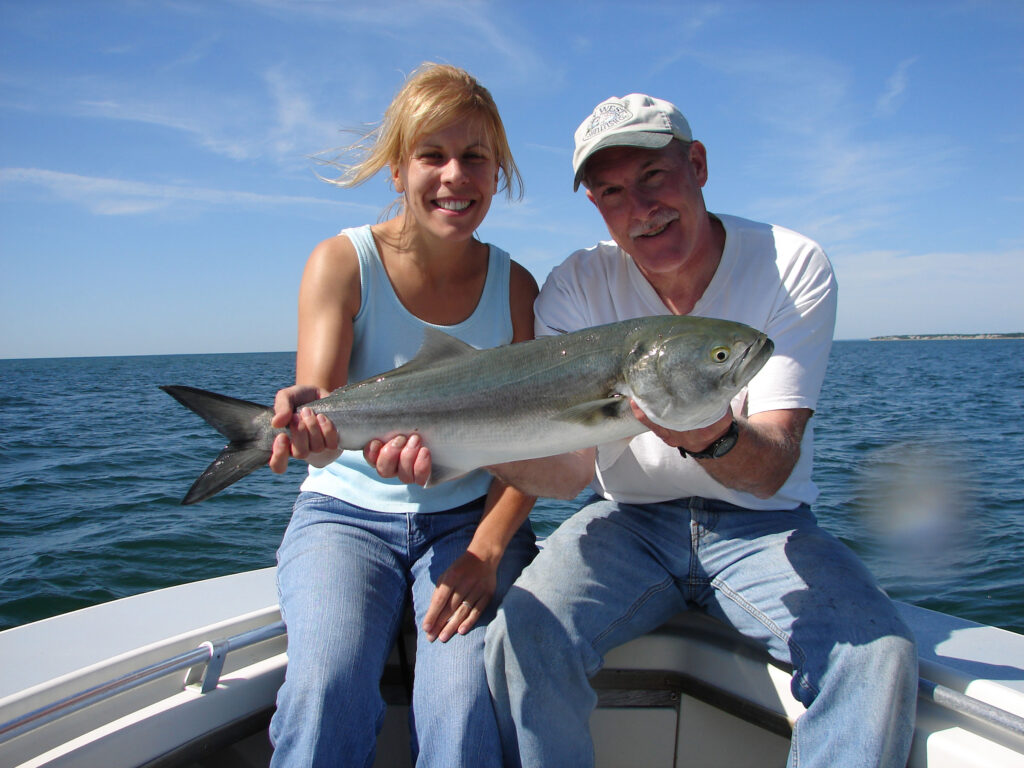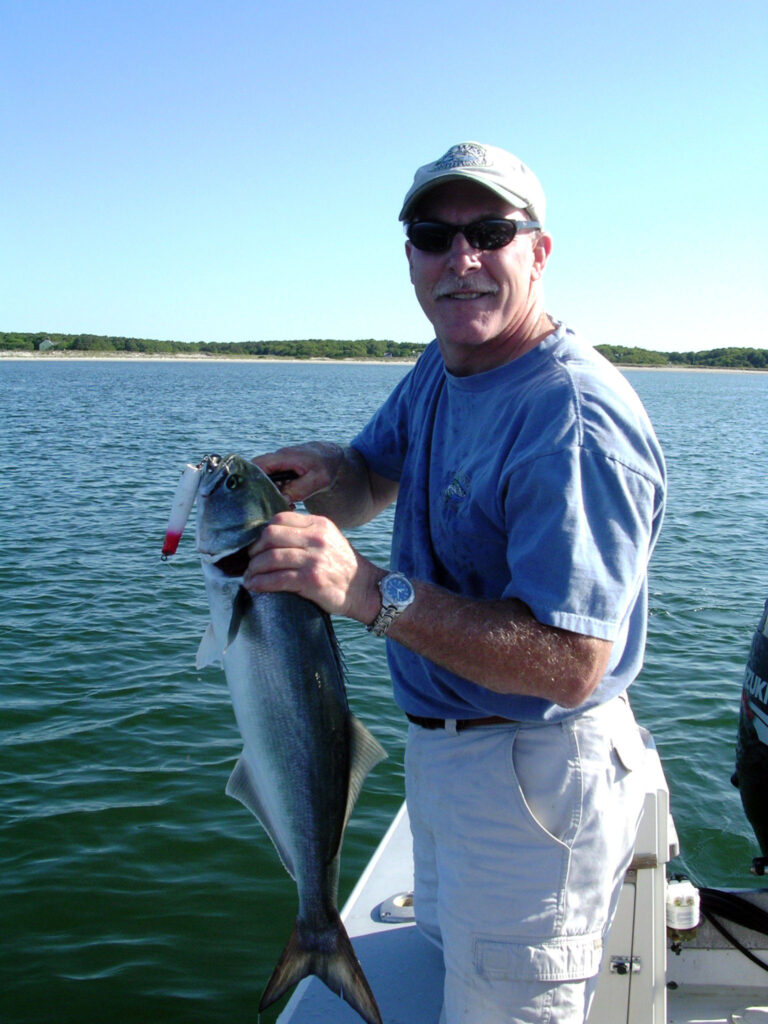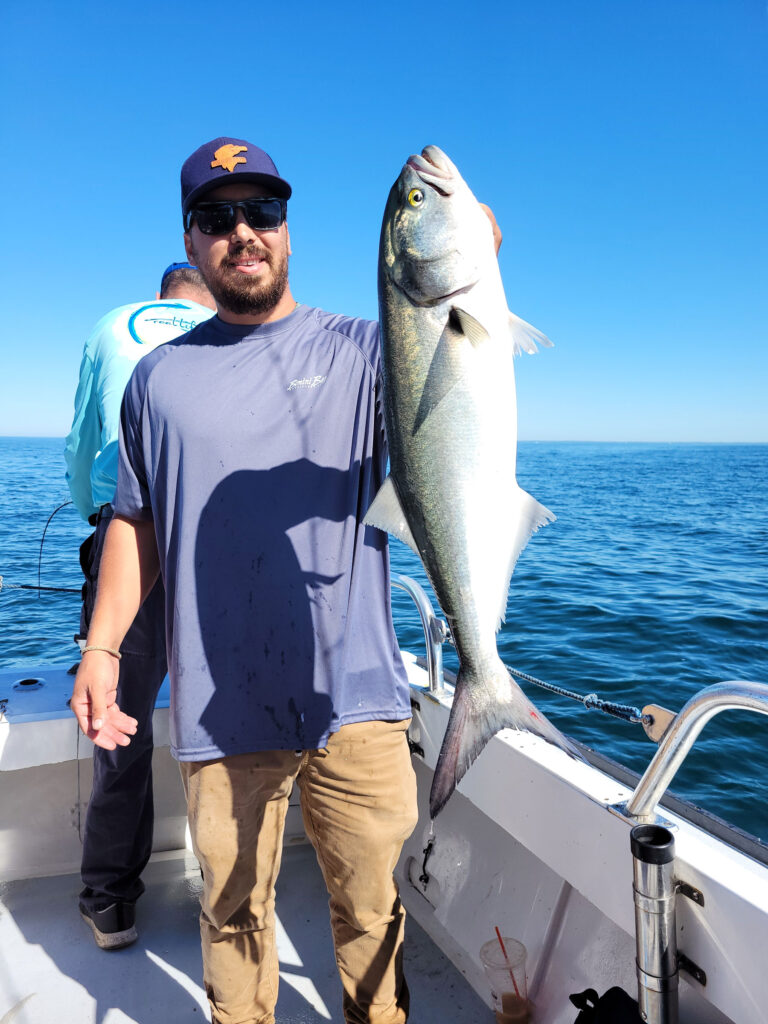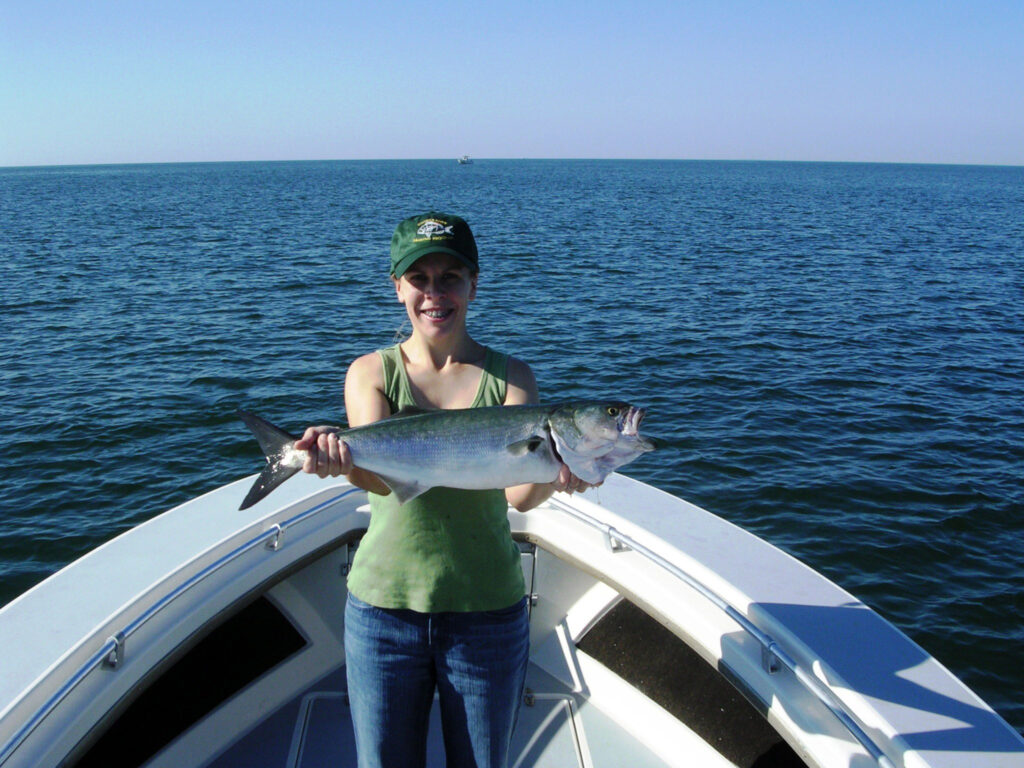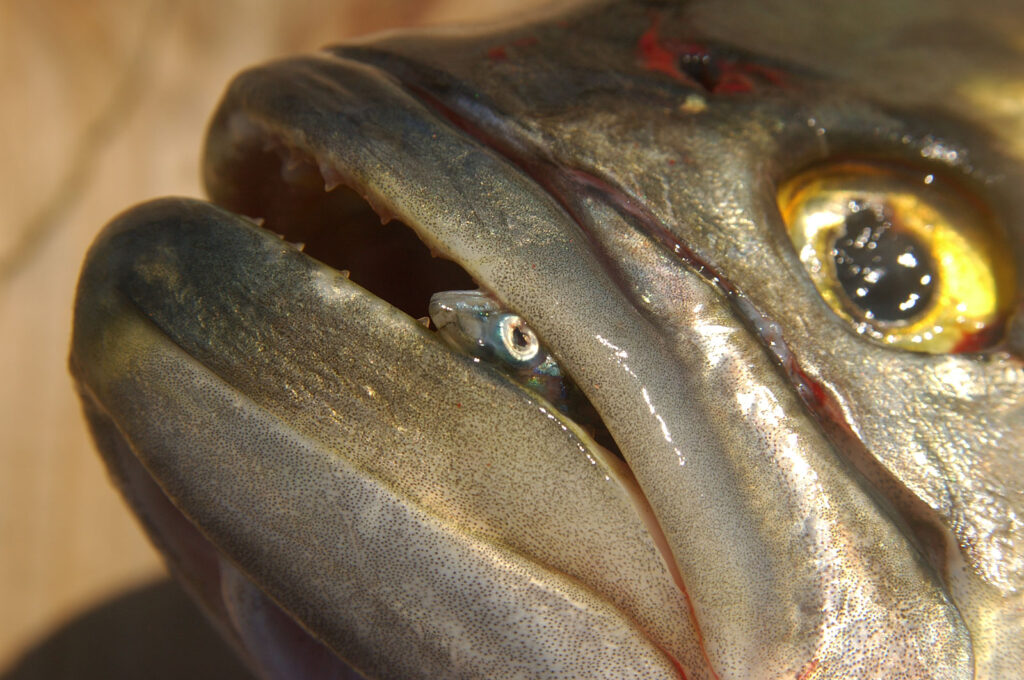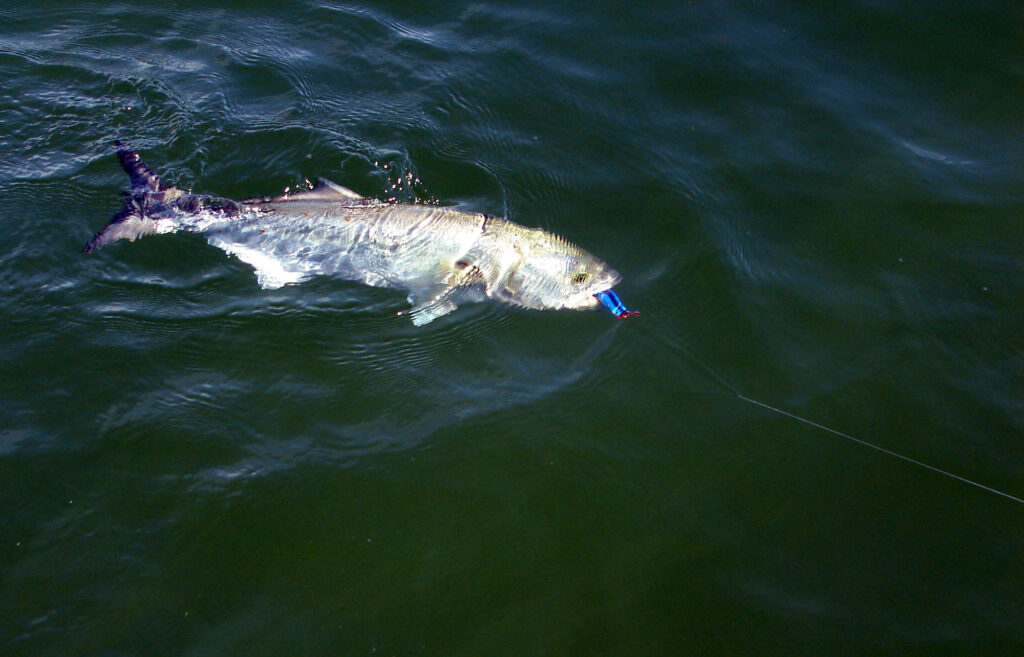Bluefish
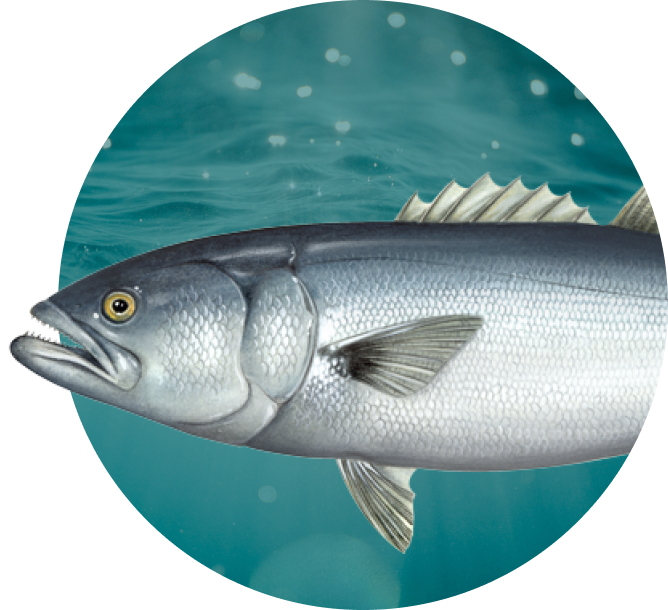
Latest News and Resources
-
Addendum XXXVI to the Summer Flounder, Scup and Black Sea Bass Fishery Management Plan and Addendum III to the Bluefish Fishery Management Plan
-
Meeting Summary and Motions from the Joint Meeting of the MAFMC & ASMFC Policy Board, Bluefish Board, and Summer Flounder, Scup and Black Sea Bass Board — August 2025
-
Bluefish Management Track Assessment Report — 2025
Latest News and Resources
-
Addendum XXXVI to the Summer Flounder, Scup and Black Sea Bass Fishery Management Plan and Addendum III to the Bluefish Fishery Management Plan
-
Meeting Summary and Motions from the Joint Meeting of the MAFMC & ASMFC Policy Board, Bluefish Board, and Summer Flounder, Scup and Black Sea Bass Board — August 2025
-
Bluefish Management Track Assessment Report — 2025
-
Bluefish Species Management Overview
-
Bluefish FMP Review – 2024
-
Bluefish Advisory Panel Fishery Performance Report — June 2025
-

Population Abundance
Not overfished

Fishing Mortality
Overfishing not occurring
Current Status
Stock status based on 2025 management track stock assessment. Amendment 2 (2021) established a 7-year rebuilding program, which will be in effect until biomass reaches target. Management track assessment scheduled for 2027.
Meeting Calendar
Next Meeting
-
Dec 15–18, 2025
MidAtlantic Fishery Management Council
The Madison Hotel, 1177 15th Street NW, Washington, DC 20005
-
Recent Management Actions
Contacts
- Chelsea Tuohy, FMP Coordinator (CTuohy@asmfc.org)
- Management Board, Marty Gary, Chair
- Technical Committee, Michael Celestino, Chair
- Advisory Panel
Species Information
Bluefish are dynamic, migratory predators found along the Atlantic coast from Maine to Florida, highly prized by recreational anglers for their spirited fight and significant role in marine ecosystems. Managed under the Interstate Fishery Management Plan, bluefish fisheries employ quota systems, size and bag limits, and seasonal closures to ensure sustainable harvests and protect spawning populations. Recent stock assessments indicate healthy populations without overfishing, and ongoing adaptive management measures support the species’ resilience and long-term viability for both fisheries and coastal communities.
Management
In June of 2021, the Board and Council jointly recommended approval of Amendment 2 (the Bluefish Allocation and Rebuilding Amendment) to the Interstate Fishery Management Plan (FMP) for Bluefish. The Amendment updates the FMP goals and objectives, initiates a 7-year rebuilding plan, establishes new allocations between the commercial and recreational sectors, implements new commercial allocations to the states, revises the process for quota transfers between sectors, and revises how the management plan accounts for management uncertainty. Bluefish are now managed under Amendments 1 and 2 and Addendum I.
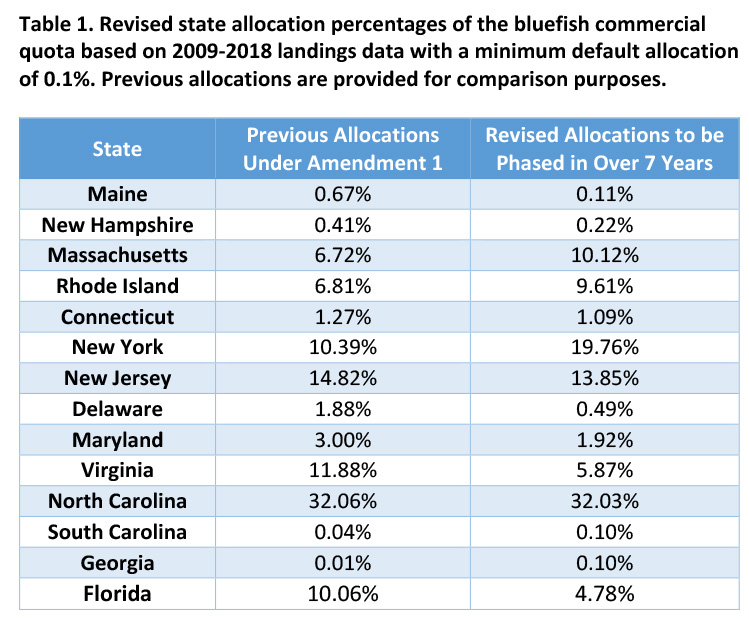
Since the passage of Addendum I in 2012, a coastwide biological sampling program has been underway to improve the quantity and quality of information used in future bluefish stock assessments. Amendment 2 to the Bluefish FMP allocates 86% of the resource to recreational fisheries and 14% to commercial fisheries. Annually, a portion of the recreational or the commercial sector’s quota can be transferred to the other sector (not to exceed 10% of the acceptable biological catch) if it is anticipated that one of the sectors will not harvest its full quota. The commercial fishery is controlled through state-by-state quotas based on historic landings from 2009-2018. These new state-by-state quotas implemented through Amendment 2 will be phased in over a seven-year period to minimize the economic impact on commercial fisheries. Since 2020, recreational fishery has been managed under a coastwide 3-fish bag limit for private anglers and shore-based fishermen, and a 5-fish bag limit for for-hire anglers.
Based on the 2025 management track stock assessment findings and rebuilding plan projections, the Board and Council set new specifications for the 2026 and 2027 fishing seasons. For 2026, the commercial quota was set at 4.66 million pounds and the recreational harvest limit (RHL) was set at 22.02 million pounds. Due to the increase in RHL, recreational bag limits will increase in 2026 and 2027 to include a 5-fish bag limit for private anglers and a 7-fish bag limit for for-hire anglers.
Stock Status
Results of the 2025 management track stock assessment conducted by the Northeast Fisheries Science Center found the Atlantic bluefish stock was not overfished and not experiencing overfishing in 2024. Although the stock is no longer overfished, Atlantic bluefish will remain in the rebuilding plan outlined in Amendment 2 until the stock rebuilds to the target level of spawning stock biomass (SSB). The updated stock assessment incorporated data through 2024. SSB in 2024 was estimated to be 170 million pounds, which is 89% of the SSB target.
Fishing mortality (F) in 2024 was estimated to be 0.108, which is 47% of the overfishing threshold of FMSY proxy=0.232. Although fishing mortality was below the threshold in 2024, fishing mortality exceeded the updated threshold every year from 1985 to 2019. The largest recruitment in the time series occurred in 1989 at 350 million fish, and the lowest recruitment was in 2019 at 67 million fish. Recruitment has increased since 2019 but has remined below the time series average over the past 10 years except in 2024. The next management track stock assessment for bluefish is scheduled for 2027.
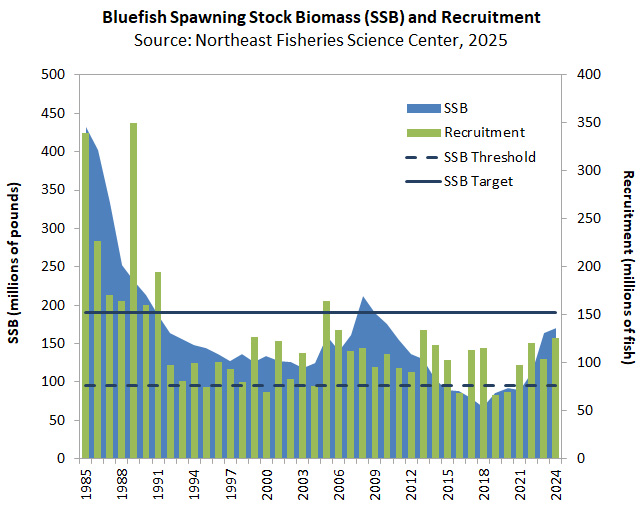
Commercial & Recreational Fisheries
Bluefish are predominantly a recreational fishery, with recreational landings accounting for approximately 85% of total landings by weight in recent years. As bluefish migrate seasonally up and down the Atlantic coast, anglers from Maine to Florida target these voracious predators near inlets, shoals, and rips, where they come to feed on large schools of bait.
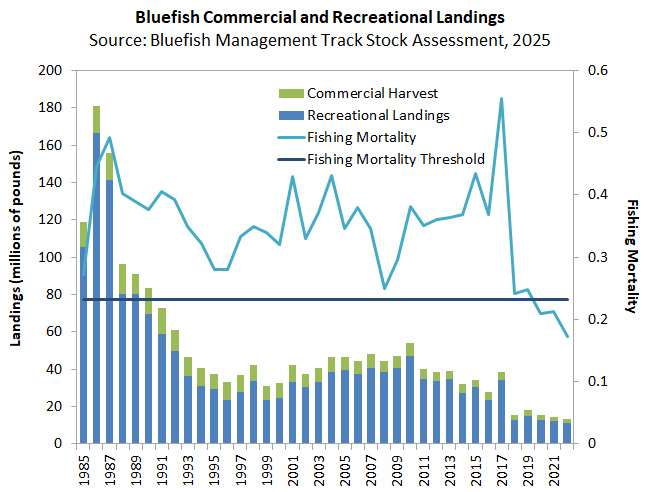
Recreational harvest peaked at 166 million pounds in 1986, but quickly declined in the 80s and 90s. The most recent 10 year average annual recreational harvest of bluefish is approximately 18 million pounds. In 2024, recreational anglers harvested an estimated 5.1 million fish weighing 13 million pounds. Harvest during 2018-2024 was exceptionally low compared to the ten-year average. Bluefish recreational releases have averaged approximately two thirds of the total catch in numbers of fish since 1999.
Commercial landings decreased from 13.5 million pounds in 1985 to 7.4 million pounds in 1999. Since a state-specific quota system was implemented in 2000, commercial landings have averaged around 5.3 million pounds annually. 2022 marks a commercial landings time series low of 2.3 million pounds. In 2024, the majority of commercial bluefish landings came from North Carolina, New York, Virginia and Massachusetts.
Life History
Bluefish (Pomatomus saltatrix) are a migratory, oceanic species found throughout the world in most temperate, coastal regions, except the eastern Pacific. Bluefish migrate seasonally, moving north in spring and summer as water temperatures rise and moving south in autumn and winter to waters in the South Atlantic Bight. During the summer, concentrations of bluefish are found in waters from Maine to Cape Hatteras, North Carolina. In winter they tend to be found offshore between Cape Hatteras and Florida. Bluefish generally school by size, with schools that can cover tens of square miles of ocean, equivalent to around 10,000 football fields.
Bluefish are fast growers and opportunistic predators, feeding voraciously on almost any prey they can capture. Bluefish live up to 12 years and may exceed lengths of 39″ and weights of 31 pounds. Bluefish reach sexual maturity at age two and spawn offshore from Massachusetts through Florida. Discrete groups spawn at different times and are referred to by the season in which they spawn: the spring-spawned cohort and the summer-spawned cohort. Recent research has also identified a fall-spawned cohort, demonstrating an expanded and prolonged spawning season. The cohorts mix extensively on the fishing grounds and probably comprise a single genetic stock.
News & Resources
Explore recent news, management updates, and scientific reports to gain a deeper understanding of ongoing conservation efforts and sustainability strategies.
-
Recreational Measures Setting Process for Summer Flounder, Scup, Black Sea Bass, and Bluefish
-
The Mid-Atlantic Fishery Management Council met August 12-14, 2023, in Annapolis, MD. As part of the meeting the Atlantic States Marine Fisheries Commission’s (Commission) Interstate Fisheries Management Program Policy Board (Policy Board), Bluefish Management Board (Board), and Summer Flounder, Scup and Black Sea Bass Management Board (Board), met jointly with the Council to take action…
-
This assessment of the Atlantic Bluefish (Pomatomus saltatrix) stock is a management track update assessment of the existing 2022 research track assessment (NEFSC 2022). Stock status for bluefish from the research track assessment (data through 2021) found the stock was not overfished, and overfishing was not occurring.
-
Prepared for the Commissioner Manual
-
-
The Mid-Atlantic Fishery Management Council’s (Council) and the Atlantic States Marine Fisheries Commission’s (Commission) Bluefish Advisory Panels (AP) met via webinar on June 12, 2025 to review the Fishery Information Document and develop the following Fishery Performance Report. The primary purpose of this report is to contextualize catch histories by providing information about fishing effort,…
-
-
-
-
The MAFMC and ASMFC Interstate Fisheries Management Program Policy Board (Policy Board) have approved modifications to the process for setting recreational measures (bag, size, and season limits), as well as the recreational accountability measures, for summer flounder, scup, black sea bass, and bluefish. The MAFMC recommended these changes through a framework action, and the Policy…
-
-
The Mid-Atlantic Fishery Management Council’s (Council’s) Summer Flounder, Scup, and Black Sea Bass and Bluefish Advisory Panels (APs) met jointly with the Atlantic States Marine Fisheries Commission’s (Commission’s) Summer Flounder, Scup, and Black Sea Bass and Bluefish APs on March 13, 2025 to review public comment, review a summary of the recent Fishery Management Action…
-
-
-
This press release revises the February 3rd announcement by changing the date of the New Jersey hearing from February 24 to February 25. The hearing time and location remain the same.
Get Hooked on ASMFC News
Dive into the latest updates and catch all the important news by joining our newsletter mailing list. Stay in the loop with meeting agendas, fisheries management news, and more.
